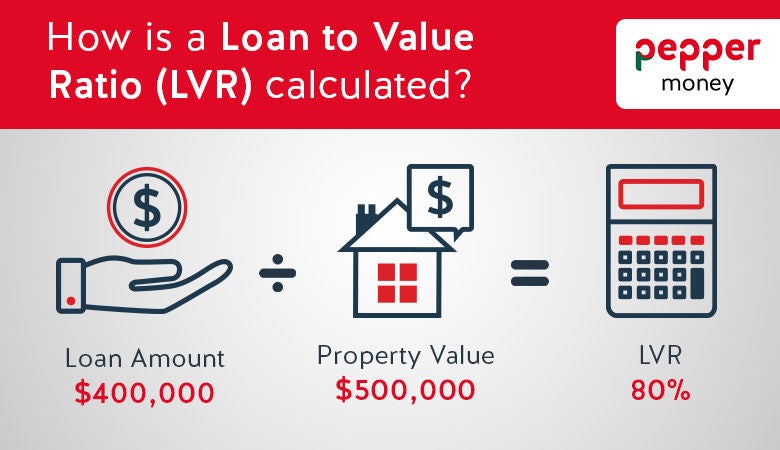What does loan to value ratio (LVR) mean on my home loan?

What’s Loan to Value Ratio? Loan to Value Ratio, also known as LVR, is the amount you are borrowing (as a percentage) of the value of the property. It is used by lenders as a measure when assessing the risk of a loan.
The video below goes into more depth about LVR and the closely related LMI - Lender's Mortgage Insurance.
Saving the deposit for your first place can be daunting. Most lenders won't talk to you unless you've saved up at least 10% of the property price, plus the money to cover government and legal fees. Many lenders also keep their best home loan deals for those who have at least a 20% deposit.
With today's house prices, that's some serious money that you'll need to save. You'll hear loan to value ratio or LVR a lot when you're comparing home loans. Thankfully, it's easy to understand. It's just the amount you need to borrow compared to the price you're paying for your property. So the larger your deposit, the lower the LVR.
This will determine what lenders you can apply to, what interest rates you'll be eligible for, and what risk fees you might have to pay.
Risk fees, yeah, you heard that right. If you're applying for a loan with an LVR above 80 which means you've got less than a 20% deposit, you'll often need to pay Lender's Mortgage Insurance or a similar risk fee. These fees can range from a few thousand dollars to tens of thousands of dollars depending on the lender and your property price.
This protects the lender in case you default on the loan and they need to sell the property at a loss. While there isn't any direct benefit to the borrower, it does mean you can get on the property ladder with a smaller deposit.
As you save more towards a property, the LVR decreases and home loans usually become more competitive. Say hello to better interest rates and lower or even no risk fees.
So if you want to get the lowest interest rate possible and avoid paying LMI or a similar risk fee then you'll usually need to save up at least a 20% deposit and have an LVR of 80.
However, with house prices rising, waiting to save up that extra deposit may see you priced out of the market, so you might consider it worth paying the extra fees to get your foot in the door sooner. You'll also need to keep some cash aside to pay for your legal and settlement fees, not to mention the cost of furnishing your property. It's a lot to weigh up. If you need any more hints and tips for your home loan journey then visit peppermoney.com.au. We're here to help.
How to calculate LVR?
For example, if the value of the property is $500,000 and you have a deposit of $100,000, you’d need a loan amount of $400,000 (excluding fees). To calculate your LVR, divide the amount you need to borrow ($400,000) by the value of the property ($500,000) and multiply this by 100 to give you a percentage.
$400,000/$500,000 x 100 = 80%
Try our LVR calculator at the bottom of the page to quickly see how different deposit and purchase price options work out.

What are some of the benefits of a lower LVR?
Loan to Value Ratio plays a vital role in the assessment of a loan and can influence in how much you can borrow from a lender. Ultimately the higher your LVR is, the riskier your loan is to a lender, so the lower your borrowing power may be.
Let’s say that the property value is fixed at a certain value ($500,000 for arguments sake), then the larger your home deposit, the lower your LVR will be. This means that you’re contributing more equity towards the property, and the lenders’ exposure is reduced if you’re unable to meet your repayments. This means that you may be eligible for more favourable interest rates or loan terms. So, it’s important to keep in mind your LVR when figuring out how much you can borrow.
How your LVR influences your mortgage
An application with an LVR of 80% or more may be considered higher risk by a lender and as a result you may be required to pay Lenders Mortgage Insurance (LMI). LMI protects the lender if you default on your home loan. Even though you pay for it, LMI protects the lender - not you.
At Pepper Money, we don’t charge LMI on any of our home loans, but we do charge a risk fee based on your LVR. This is known as a Lender Protection Fee (LPF).
Unlike traditional lenders, we’re self-insured so LPFs allow us to manage our own risks when it comes to assessing your home loan application, without having to seek third-party LMI approval. This allows us to be more flexible as we’re not reliant on an insurers criteria. Learn more about LPFs.
Loan to Value Ratio (LVR) Calculator
LVR is important in determining which options or interest rate you might be eligible for. See how your purchase price and deposit stack up using our LVR calculator. Remember, you'll need an LVR of 95% or less to apply for a home loan with us.
Sign up to our newsletter
If you like this article, you'll love our Really helpful newsletter.
Personal information is collected, used, stored and disclosed in accordance with Pepper's Privacy Policy. I understand I can unsubscribe at any time.
Information provided is factual information only and is not intended to imply any recommendation about any financial product(s) or constitute tax advice. If you require financial or tax advice you should consult a licensed financial or tax adviser.
All applications for credit are subject to credit assessment, eligibility criteria and lending limits. Terms, conditions, fees and charges apply.
The results of the borrowing power calculator are based on information you have provided and is to be used as a guide only. The output of the calculator is subject to the assumptions provided in the calculator (see 'about this calculator') and are subject to change. It does not constitute a quote, pre-qualification, approval for credit or an offer for credit and you should not enter commitments based on it. The interest rates do not reflect true interest rates and the formula used for the purpose of calculating estimated borrowing power is based on the assumption that interest rates remain constant for the chosen loan term. Your borrowing power amount will be different if a full application is submitted and we complete responsible lending assessment. The results in the calculator do not take into account loan setup or establishment fees nor government, statutory or lenders fees, which may be applicable from time to time. Calculator by Widgetworks.
Pepper Money Personal Loans is a brand of Pepper Money Limited. Credit is provided by Now Finance Group Pty Ltd, Australian Credit Licence Number 425142 as agent for NF Finco 2 Pty Limited ACN 164 213 030. Personal information for Pepper Money Personal Loans is collected, used and disclosed in accordance with Pepper’s Privacy Policy & the credit provider’s Privacy Policy.
Pepper Money Limited ABN 55 094 317 665; AFSL and Australian Credit Licence 286655 (“Pepper”). All rights reserved. Pepper is the servicer of home loans provided by Pepper Finance Corporation Limited ABN 51 094 317 647. Pepper Asset Finance Pty Limited ACN 165 183 317 Australian Credit Licence 458899 is the credit provider for asset finance loans.
Pepper and the Pepper Money logo are registered trademarks of Pepper Group Assets (Australia) Pty Limited and are used under licence.




